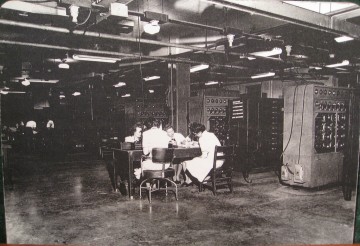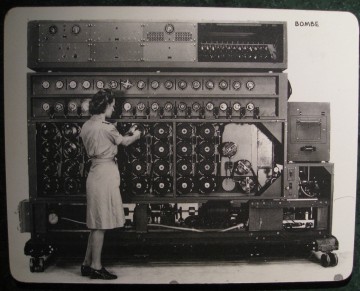Wheel Bank - US Navy Cryptanalytic Bombe
Wheel Banks represent the four rotors used on the German U-boat Enigma. Each column interconnects the four rotors, or commutators, in that column. The top commutator represented the fourth, or slowest, rotor on the Enigma, while the bottom wheel represented the rightmost, or fastest, rotor. The WAVES set the rotors according to the menu developed by the cryptanalysts. The first were set to 00, and each set after that corresponded to the plain/cipher link with the crib (the assumed plain test corresponding to the cipher text.) Usually this meant that each wheel bank stepped up one place from the one on its left. When the machine ran, each bottom rotor stepped forward, and the machine electrically checked to see if the assigned conditions were met. If not, as was usually the case, each bottom wheels moved one more place forward. However, the bottom commutator moved at 850 rpm, so it only took twenty minutes to complete a run of all 456,976 positions.
US Navy WAVES operated the Cryptanalytic Bombes
Waves Operated the 26 Standard Bombes (N-530) and 3 special Bombes (N-800) on the Main Deck of Building 4 at the Navy's Communication Annex on Nebraska Avenue in Washington, DC
Bombes began arriving at the Navy's Communication Annex on Nebraska Avenue in Washington, DC at a rate of four per week beginning in September, 1943. Women known as WAVES (Women Accepted for Voluntary Emergency Service) operated the machines, but knew only that they were doing code work. Although they were not informed of the reult of their work, they did understand its importance. Because of their dedication and loyalty, German U-boat messages could be read in near real-time, and lives of men, Allied and German, were spared.
Source: National Cryptologic Museum
Bombe on Wikipedia
Once the British had given the Americans the details about the bombe and its use, the US had the National Cash Register Company manufacture a great many additional bombes, which the US then used to assist in the code-breaking. These ran much faster than the British version, so fast that unlike the British model, which would freeze immediately (and ring a bell) when a possible solution was detected, the NCR model, upon detecting a possible solution, had to "remember" that setting and then reverse its rotors to back up to it (meanwhile the bell rang).
US Navy Cryptanalytic Bombe
A US Navy WAVE sets the Bombe rotors prior to a run
The US NAvy cryptanalytic Bombes had only one purpose: Determine the rotor settings used on the German cipher machine ENIGMA. Originally designed by Joseph Desch with the National Cash Register Company in Dayton, Ohio, the Bombes worked primarily against the German Navy's four-rotor ENIGMAs. Without the proper rotor settings, the messages were virtually unbreakable. The Bombes took only twenty minutes to complete a run, testing the 456,976 possible rotor settings with one wheel order. Different Bombes tried different wheel orders, and one of them would have the final correct settings. When the various U-boat settings were found, the Bombe could be switched over to work on German Army and Air Force three-rotor messages.
Source: National Cryptologic Museum
Comment on the above
The four rotor system had 26^4 or 456,976 settings whilst the theree rotor system had 26^3 or 17,756 settings. It looks like the problem scale in a linear way as it took 50 seconds to check 17,756 setting (~350 per second) while the four rotor solution in 20 minutes is ~ 380 settings per second.
I also think the designer Joseph Desch sounds like a remarkable engineer that I never heard of before.
Bombe on Wikipedia
Once the British had given the Americans the details about the bombe and its use, the US had the National Cash Register Company manufacture a great many additional bombes, which the US then used to assist in the code-breaking. These ran much faster than the British version, so fast that unlike the British model, which would freeze immediately (and ring a bell) when a possible solution was detected, the NCR model, upon detecting a possible solution, had to "remember" that setting and then reverse its rotors to back up to it (meanwhile the bell rang).
Source of following material : National Cryptologic Museum
Diagonal Board is the heart of the Bombe unit. Electrically, it has 26 rows and 26 columns of points, each with a diagonal wire connection. These wires connect each letter in a column with the same position in each row. A letter cannot plug into itself; these are known as "self-steckers." The resulting pattern is a series of diagonal lines. The purpose of the diagonal board is to eliminate the complications caused by the Enigma's plugboard. Given specific rotor settings, only certain plugboard settings can result in the proper encrypted letter. The diagonal board disproved hundreds of rotor settings, allowing for only a few possibly correct settings to result in a "strike".
Amplifier Chassis had two purposes, first to detect a hit and second to determine if it was useful. It provided the tie-in from the diagonal board, the locator, and the printer circuits.
Thyratron Chassis was the machine's memory. Since the wheels spun at such a high speed, they could not immediately stop rotating when a correct hit was detected. The Thyratron remembered where the correct hit was located and indicated when the Bombe has rewound to that position. It also told the machine when it had completed a run and gave the final stop signal.
Switch Banks tell the Bombe what plain to cipher letters to search for. Using menus sent to the Bombe deck by cryptanalysts, WAVES set each dial using special wrenches. 00 equates to the letter A and 25 to the letter Z. The dials work together in groups of two. One dial is set to the plain test letter and the other to its corresponding cipher letter as determined by cryptanalysts. There are sixteen sets of switch banks, however, only fourteen were required to complete a run. As the machine worked through the rotor settings, a correct hit was possible if the electrical path in all fourteen switch banks corresponded to each of their assigned plaintext/cipher combinations.
Wheel Banks represent the four rotors used on the German U-boat Enigma. Each column interconnects the four rotors, or commutators, in that column. The top commutator represented the fourth, or slowest, rotor on the Enigma, while the bottom wheel represented the rightmost, or fastest, rotor. The WAVES set the rotors according to the menu developed by the cryptanalysts. The first were set to 00, and each set after that corresponded to the plain/cipher link with the crib (the assumed plain test corresponding to the cipher text.) Usually this meant that each wheel bank stepped up one place from the one on its left. When the machine ran, each bottom rotor stepped forward, and the machine electrically checked to see if the assigned conditions were met. If not, as was usually the case, each bottom wheels moved one more place forward. However, the bottom commutator moved at 850 rpm, so it only took twenty minutes to complete a run of all 456,976 positions.
Printer automatically printed the information of a possible hit. When the Bombe determined that all the possible conditions had been met. it printed wheel order, rotor settings and plugboard connections.
Motor Control Chassis controlled both forward and reverse motors. The Bombe was an electromechanical machine and required a number of gauges for monitoring. It also needed a Braking Assembly to slow the forward motion when a hit was detected and to bring the machine to a full stop when a run was completed.
Bild: brewbooks



